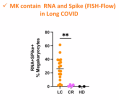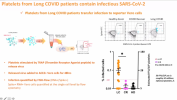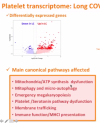You are using an out of date browser. It may not display this or other websites correctly.
You should upgrade or use an alternative browser.
You should upgrade or use an alternative browser.
November 14th, two days from now.
Morgane Bomsel, who last year presented some striking differences in megakaryocyte and platelet viral persistence, is presenting again.
Morgane Bomsel, who last year presented some striking differences in megakaryocyte and platelet viral persistence, is presenting again.
Morgane Bomsel, PhD
12:40 – 12:50 pm ET (4:40- 4:50 pm UTC)
SARS-CoV-2 persistence & impact on Long COVID megakaryocytes and platelets
Dr. Bomsel will discuss her research program to determine if replication-competent SARS-CoV-2 virus persists in Long COVID bone marrow-derived cells and platelets. She will review potential associations with dysregulated energy metabolism & hormonal changes.
Could be some worthwhile research amongst all this. The do seem to be largely focused on viral persistence.
I think I'll wait for papers to be published rather than trying to keep up from short talks. I assume the main value of this is expected to be for scientists to get a snapshot of each others work and ideas, and follow it up with private discussions.
I think I'll wait for papers to be published rather than trying to keep up from short talks. I assume the main value of this is expected to be for scientists to get a snapshot of each others work and ideas, and follow it up with private discussions.
Some notes on Morgane Bomsel's talk:
This is about patients with symptoms more than 6 months after acute COVID, and median 16 months after.
She showed a plot of SARS-CoV-2 detected in megakaryocytes which is the same as the one shown last year:
Around 30% of megakaryocytes in long COVID have SARS-CoV-2 RNA and spike:

From a sample of 17 LC patients and 6 recovered, most LC patients had platelets capable of infecting other cells, and none of the recovered did. I'm not sure if this is a random sample from their full cohort of > 100 LC.

This chart for spike in long COVID plasma is more filled in than last year's. She said they've studied more than 140 patients for this.

It's kind of strange because in the linked slide from last year, there were no points at 0 and the pink group (recovered controls) ranged from around 0.5 to 2 pg/mL, but in this slide they range from 0 to 0.8 pg/mL.
A topic she went into more this time was characterizing the platelets in LC. They were shifted away from mitochondrial respiration and more towards glycolysis:

And pathways affected when looking at gene expression in platelets:

This is about patients with symptoms more than 6 months after acute COVID, and median 16 months after.
She showed a plot of SARS-CoV-2 detected in megakaryocytes which is the same as the one shown last year:
Around 30% of megakaryocytes in long COVID have SARS-CoV-2 RNA and spike:

From a sample of 17 LC patients and 6 recovered, most LC patients had platelets capable of infecting other cells, and none of the recovered did. I'm not sure if this is a random sample from their full cohort of > 100 LC.

This chart for spike in long COVID plasma is more filled in than last year's. She said they've studied more than 140 patients for this.

It's kind of strange because in the linked slide from last year, there were no points at 0 and the pink group (recovered controls) ranged from around 0.5 to 2 pg/mL, but in this slide they range from 0 to 0.8 pg/mL.
A topic she went into more this time was characterizing the platelets in LC. They were shifted away from mitochondrial respiration and more towards glycolysis:

And pathways affected when looking at gene expression in platelets:

jnmaciuch
Senior Member (Voting Rights)
Was this a new slide? I'm trying to zoom in more to the flow plots and can't really see. But if this is real and not an artifact it could be really interestingFrom a sample of 17 LC patients and 6 recovered, most LC patients had platelets capable of infecting other cells, and none of the recovered did. I'm not sure if this is a random sample from their full cohort of > 100 LC.
My mistake, I just looked at the video from last year, and it's the same plot. Timestamped link.Was this a new slide? I'm trying to zoom in more to the flow plots and can't really see. But if this is real and not an artifact it could be really interesting
ahimsa
Senior Member (Voting Rights)
The Sick Times is reporting on this for those who are interested.
Live blog: PolyBio’s Fall 2025 Symposium shares Long COVID and related disease research updates
Live blog: PolyBio’s Fall 2025 Symposium shares Long COVID and related disease research updates
Grouping the video links.
General
0:00: Amy Proal--An overview of PolyBio’s complex chronic illness research & clinical trials program
5:40:02: Max Qian--Long COVID endotype identification
Viral Persistence
10:01: Nicholas Huot--SARS-CoV-2 persistence: a focus on natural killer cell & macrophage dynamics
1:27:40: Sara Cherry--Long COVID: Defining the viral RNA reservoir in the gastrointestinal tract
1:37:02: Christopher DuPont--An update on the biopsy and surgical sample Tissue Analysis Pipeline
1:45:22: Morgane Bomsel--SARS-CoV-2 persistence & impact on Long COVID megakaryocytes and platelets
2:00:21: Esen Sefik--A humanized mouse model of SARS-COV-2 RNA persistence
2:38:31: Jesus Estevez--Persistence of viral antigens and immune-endocrine features in Long COVID
3:00:00: Lael Yonker--Neutrophil – spike protein interactions in pediatric Long COVID
3:12:44: Shannon Stott--Microfluidics capture of SARS-CoV-2 particles in Long COVID blood
3:23:15: Chiara Giannarelli--Deep characterization of SARS-CoV-2 cardiovascular reservoirs.
3:35:35: Michael Peluso--Pivoting LIINC into the study of ME/CFS pathogenesis—CHIIME program
3:46:30: Steve Deeks--VIPER: a Long COVID diagnostic test validation program
3:59:12: David Putrino--Combination antivirals in the treatment of Long COVID
4:33:01: Tim Henrich--Long COVID tissue biopsy program update
4:44:01: Francis Eun Lee--Use of MENSA to identify SARS-CoV-2 persistence and viral reactivation in Long COVID
4:58:27: Marta Mirabent--SARS-CoV-2 persistence & T cell activity in the female reproductive tract
5:11:08: Mark Painter--T cells as biosensors of viral persistence in Long COVID
6:02:40: Zian Tseng--The COVID POST SCD (POstmortem Systematic invesTigation of Sudden Cardiac Death) Study
6:15:31: Michael Peluso--Supporting the immune response in Long COVID: INTERRUPT-LC
Proteomics
24:55: David Price--Mapping lung tissue correlates of breathlessness in Long COVID
5:28:27: Marcelo Freire--Proteomics reveals immune markers in Long COVID vagal nerve stimulation clinical trial
Neuroinflammation
42:00: Michael Van Elzakker--Long COVID & ME/CFS neuroinflammation and neutrophil function
5:53:07: Mario Murakami--Vagus nerve sensitivity as a common infection-associated chronic disease mechanism
Coagulation
53:08: Luane Spamer--Development of a Point-of-Care Microclot Detection and Characterization Device
2:48:10: David-Izquierdo Garcia--Evaluation of tissue fibrin accumulation in Long COVID via PET imaging & blood analysis
Immune / Interferon
1:03:21: Marcus Buggert--SARS-CoV-2 gut and lymphoid pathology, plus Long COVID longitudinal study
1:16:53: Michela Locci--Lymph node immune responses in Long COVID
Miscellaneous
2:25:33: Ed Breitschwerdt--Developing advanced diagnostics to identify the Babesia parasite
2:11:01: Benjamin Readhead--Toward precision Alzheimer’s: a salivary cytomegalovirus biomarker for patient stratification
4:19:52: William Eimer--Viruses as drivers of Alzheimer’s disease pathology
4:10:57: Beverly Peng--Mapping the landscape of endometriosis tissue
General
0:00: Amy Proal--An overview of PolyBio’s complex chronic illness research & clinical trials program
5:40:02: Max Qian--Long COVID endotype identification
Viral Persistence
10:01: Nicholas Huot--SARS-CoV-2 persistence: a focus on natural killer cell & macrophage dynamics
1:27:40: Sara Cherry--Long COVID: Defining the viral RNA reservoir in the gastrointestinal tract
1:37:02: Christopher DuPont--An update on the biopsy and surgical sample Tissue Analysis Pipeline
1:45:22: Morgane Bomsel--SARS-CoV-2 persistence & impact on Long COVID megakaryocytes and platelets
2:00:21: Esen Sefik--A humanized mouse model of SARS-COV-2 RNA persistence
2:38:31: Jesus Estevez--Persistence of viral antigens and immune-endocrine features in Long COVID
3:00:00: Lael Yonker--Neutrophil – spike protein interactions in pediatric Long COVID
3:12:44: Shannon Stott--Microfluidics capture of SARS-CoV-2 particles in Long COVID blood
3:23:15: Chiara Giannarelli--Deep characterization of SARS-CoV-2 cardiovascular reservoirs.
3:35:35: Michael Peluso--Pivoting LIINC into the study of ME/CFS pathogenesis—CHIIME program
3:46:30: Steve Deeks--VIPER: a Long COVID diagnostic test validation program
3:59:12: David Putrino--Combination antivirals in the treatment of Long COVID
4:33:01: Tim Henrich--Long COVID tissue biopsy program update
4:44:01: Francis Eun Lee--Use of MENSA to identify SARS-CoV-2 persistence and viral reactivation in Long COVID
4:58:27: Marta Mirabent--SARS-CoV-2 persistence & T cell activity in the female reproductive tract
5:11:08: Mark Painter--T cells as biosensors of viral persistence in Long COVID
6:02:40: Zian Tseng--The COVID POST SCD (POstmortem Systematic invesTigation of Sudden Cardiac Death) Study
6:15:31: Michael Peluso--Supporting the immune response in Long COVID: INTERRUPT-LC
Proteomics
24:55: David Price--Mapping lung tissue correlates of breathlessness in Long COVID
5:28:27: Marcelo Freire--Proteomics reveals immune markers in Long COVID vagal nerve stimulation clinical trial
Neuroinflammation
42:00: Michael Van Elzakker--Long COVID & ME/CFS neuroinflammation and neutrophil function
5:53:07: Mario Murakami--Vagus nerve sensitivity as a common infection-associated chronic disease mechanism
Coagulation
53:08: Luane Spamer--Development of a Point-of-Care Microclot Detection and Characterization Device
2:48:10: David-Izquierdo Garcia--Evaluation of tissue fibrin accumulation in Long COVID via PET imaging & blood analysis
Immune / Interferon
1:03:21: Marcus Buggert--SARS-CoV-2 gut and lymphoid pathology, plus Long COVID longitudinal study
1:16:53: Michela Locci--Lymph node immune responses in Long COVID
Miscellaneous
2:25:33: Ed Breitschwerdt--Developing advanced diagnostics to identify the Babesia parasite
2:11:01: Benjamin Readhead--Toward precision Alzheimer’s: a salivary cytomegalovirus biomarker for patient stratification
4:19:52: William Eimer--Viruses as drivers of Alzheimer’s disease pathology
4:10:57: Beverly Peng--Mapping the landscape of endometriosis tissue
Thanks for the list and notes, @SNT Gatchaman.
I have given up watching research videos through lack of energy and concentration.
Is there any particular work talked about that struck anyone as exciting?
They seem to be still mainly focused on viral persistence. Have any of their research projects established evidence to support that approach?
I have given up watching research videos through lack of energy and concentration.
Is there any particular work talked about that struck anyone as exciting?
They seem to be still mainly focused on viral persistence. Have any of their research projects established evidence to support that approach?
Is there any particular work talked about that struck anyone as exciting?
I liked Lael Yonker's talk.
3:00:00: Lael Yonker--Neutrophil – spike protein interactions in pediatric Long COVID
As she notes in her introduction, it's a maxim that researching (and diagnosing) children carries the benefit that they typically have "only the one thing wrong with them" ie not confounded by the various degenerative processes and diagnoses we all tend to pick up through middle age and onward.
Again this is predicated on the idea of gut viral persistence.
Multisystem inflammatory syndrome in children is driven by zonulin-dependent loss of gut mucosal barrier (2021, The Journal of Clinical Investigation)
Neutrophil profiles of pediatric COVID-19 and multisystem inflammatory syndrome in children (2022, Cell Reports Medicine)
Circulating Spike Protein Detected in Post–COVID-19 mRNA Vaccine Myocarditis (2023, Circulation)
TGFβ links EBV to multisystem inflammatory syndrome in children (2025, Nature)
Children with Post COVID-19 Multisystem Inflammatory Syndrome Display Unique Pathophysiological Metabolic Phenotypes (2025, Journal of Proteome Research)
Viral spike antigen clearance and augmented recovery in children with post-COVID multisystem inflammatory syndrome treated with larazotide (2025, Science Translational Medicine)
Quantification of fibrinaloid clots in plasma from pediatric Long COVID patients using a microfluidic assay (2025, Preprint: Research Square)
Neutrophil profiles of pediatric COVID-19 and multisystem inflammatory syndrome in children (2022, Cell Reports Medicine)
Circulating Spike Protein Detected in Post–COVID-19 mRNA Vaccine Myocarditis (2023, Circulation)
TGFβ links EBV to multisystem inflammatory syndrome in children (2025, Nature)
Children with Post COVID-19 Multisystem Inflammatory Syndrome Display Unique Pathophysiological Metabolic Phenotypes (2025, Journal of Proteome Research)
Viral spike antigen clearance and augmented recovery in children with post-COVID multisystem inflammatory syndrome treated with larazotide (2025, Science Translational Medicine)
Quantification of fibrinaloid clots in plasma from pediatric Long COVID patients using a microfluidic assay (2025, Preprint: Research Square)
Forestglip already mentioned the megakaryocytic studies (which could tie in to our discussion on bone marrow).
1:45:22: Morgane Bomsel--SARS-CoV-2 persistence & impact on Long COVID megakaryocytes and platelets
